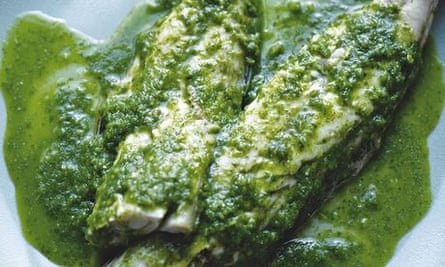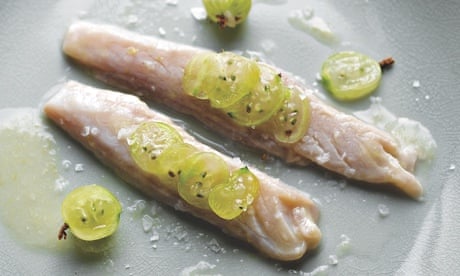Sparkling fresh mackerel is such a pretty fish. Oily, yes, but not overpowering in the way of sardines. It also has a very distinctive, rich, umami taste, and all you need to lift it higher is sweetness, saltiness, acidity and spice in some form or other. My favourites are chilli and lime, lemon and black pepper, gooseberry and ginger, and rhubarb and mustard; salt can be introduced in the form of cure or seasoning. Mackerel is as delicious raw or part-cooked as it is cooked. A pinch of salt, a squeeze of lime and a drop of sesame oil is garnish enough, but if you are prepared to take things a bit further, the results can be stunning.
Barbecued (or chargrilled) mackerel with verdita
The two chillies give this a medium heat, but if you want more of a kick, add another. To make verdita to drink, omit the salt and add 500ml pineapple juice (verdita makes a mean ceviche, too – just use it as the cure instead of the gooseberries in the recipe overleaf). Serves four.
40g coriander
20g mint
2 green jalapeño chillies
250ml pineapple juice
Juice of ½ lime
8g salt
8 mackerel fillets, central blood line and spine removed
Put the first six ingredients in a liquidiser or food processor, and blend until smooth. Strain through a fine sieve and refrigerate.
Pat dry the fillets and oil lightly on each side – this will help prevent the skin from sticking to the barbecue grill. Cook the fish skin side down on a very hot barbecue (or chargrill or griddle pan; they can be pan-fried, too). After three or so minutes, the fish will be halfway cooked through, and ready to transfer, skin side down, to a warm plate (if you prefer it cooked all the way through, flip over and grill for a few seconds longer, but remember it will "cook" more in the verdita). Pour the verdita over the fish, leave for 10 minutes, then serve in corn tacos (or make wraps with iceberg lettuce or Chinese leaf); tequila shots recommended.
Smoked mackerel
Cold smoked mackerel bears no relation to the hot smoked stuff you get in supermarkets, and to my mind it rivals smoked salmon for taste. Mackerel's relatively small size makes it much more manageable to smoke at home, though you'll need to start 48 hours ahead. The fish can be eaten straight from the smoker, but unless you give it a chance to mellow in the oil, the flavour can be a bit harsh. To complement the smoky, oily fish, go for a combination of clean acidity and sweetness: roast celeriac or beetroot, cooked until soft, left to cool and combined with a bit of the same veg grated raw in a white-wine vinegar pickle; or go for a Scandi-style garnish of sweet mustard sauce and dark rye bread. Serves four.
120g salt
80g sugar
10g fresh dill, chopped
2 large mackerel, filleted, spine and central blood line removed
30g oak chips
1 big bag of ice
Olive oil
You will also need
1 small saucepan for the oak chips
2 wire racks
1 small tray for ice
1 box or container to smoke in (we use two deep Gastronorm trays, but it can be anything fireproof that's large enough to hold the wire racks and that can be sealed shut)
Before you start, check that all the kit – pan, racks, tray – when stacked, fits inside your smoking box and that the lid is a tight fit. And find a safe outside space to put it, away from pets, small children and drunks.
Mix the salt, sugar and dill in a bowl to make the salt cure, then tip into a stainless-steel or plastic tray. Lay the fish flesh side down on the salt, cover with a lid or wrap with clingfilm, refrigerate for 24 hours.
Next day, lift the fish from its cure and rinse under cold water, rubbing the flesh gently to remove the cure, then leave under a gently running tap for 10 minutes. Pat dry the fillets with kitchen towel, then lay them skin side down on a wire rack.
Heat the oak chips in the saucepan until blackened and smoking hot, then take outside and set alight (use a stove lighter for safety). Leave to flame for a minute, then extinguish by covering the pan with a lid. Quickly put the pan of smoking chips in the bottom of the smoking box, remove the lid and top with the empty rack. Put the tray of ice on top of this, then the rack of mackerel. Cover tightly, so no smoke can escape (use foil or clingfilm around the join), and leave to smoke for 45 minutes. Remove the fish, lay in a shallow dish, cover with olive oil and leave to cure for another 24 hours.

To serve, skin the fillets (hold the fillet firmly at the tail end and run a sharp knife along its length, pressing down towards the skin), then cut each fillet lengthways into two. Your cold-smoked mackerel is now good to go.
Beetroot and horseradish cream, to go with mackerel any which way
Sweet, earthy beetroot and spicy horseradish have a magical effect on mackerel, be it fried, barbecued, smoked, soused or cured. Rye bread completes the garnish. Serves four.
200g raw beetroot
80g creme fraiche
5-8g grated raw horseradish (if you can't get hold of raw, use a couple of teaspoons of good quality creamed horseradish instead)
5g salt
Wrap each beetroot individually in foil and roast at 180C/350F/gas mark 4 for two to two and a half hours, until cooked right through. Leave to cool, then peel, remove the root and cut the flesh into small 5mm-square dice. Mix the beetroot with the creme fraiche, horseradish – fresh horseradish varies greatly in spiciness, so start with 5g and taste before adding more – and salt, and check for seasoning and spice.
Mackerel ceviche with gooseberries and ginger
The acid fruit and warm ginger harmonise beautifully with the rich fish. I like to serve this on top of wafer-thin slices of mooli, kohlrabi or turnip (use a mandoline if you have one). Serves four to six as a starter.
125g gooseberries
10g butter
15g sugar
2g salt
8g grated ginger
8 mackerel fillets, skinned, cut in half lengthways, central blood line and pin bones removed
Sea salt, to serve
Put 100g gooseberries, the butter, sugar and salt in a saucepan, add a teaspoon of water, and cook, stirring, over medium heat until the fruit softens. Cook to thicken slightly, then push through a fine sieve and leave to cool. Stir in the ginger and refrigerate. Lay the fish in the puree, coat evenly in the mix – the fish breaks easily, so handle carefully – and leave for 90 minutes. Lift out, wipe off excess puree and arrange the fish on a plate. Cut the raw gooseberries into paper-thin slices (use a mandoline, if you have one) and drape the slices over each half-fillet, tucking them underneath if the fruit is large. Drop a few crystals of salt on each fillet and eat at once.
